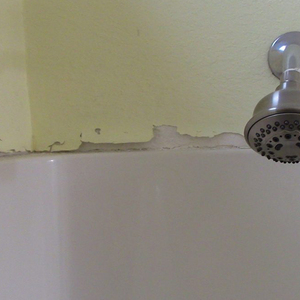Hello all. Retired carpenter here with an insulation question. My house sits on a slab with all water lines under the slab. This last summer a leak developed ondee the slab so we vacated those lines and ran all new pex lines through the attic. My current insulation i n the attic is blown fiberglass,the shake and rake kind. I need to add more insulation where the water lines are and I’m wondering if I should stick with what I currently have or switch to the blown cellulose. I live in N.W. Ohio. Any insulation experts here? Thanks
Wayne
Discussion Forum
Discussion Forum
Up Next
Video Shorts
Featured Story

Learn how to patch drywall above a fiberglass shower without totally redoing everything.
Highlights
Fine Homebuilding Magazine
- Home Group
- Antique Trader
- Arts & Crafts Homes
- Bank Note Reporter
- Cabin Life
- Cuisine at Home
- Fine Gardening
- Fine Woodworking
- Green Building Advisor
- Garden Gate
- Horticulture
- Keep Craft Alive
- Log Home Living
- Military Trader/Vehicles
- Numismatic News
- Numismaster
- Old Cars Weekly
- Old House Journal
- Period Homes
- Popular Woodworking
- Script
- ShopNotes
- Sports Collectors Digest
- Threads
- Timber Home Living
- Traditional Building
- Woodsmith
- World Coin News
- Writer's Digest


















Replies
I’d build a 3 sided box around it with rigid foam and maybe put a Hvac register in the ceiling so you’re always getting a little heat up there. Maybe like two layers of 2” foam for r-20 then bury the whole thing in loose fill.
I thought about doing that but was told it wasn't necessary. At some point they have to leave the box to go to the different rooms. I was just wondering if there was any advantage to using blown cellulose over the whole water line run.
My brother has his water lines in his attic and has blown cellulose piled pretty high on them and hasn't had any problems with them freezing. Thanks for your response.
Adding blown cellulose would be my method. I am assuming that your pex is sitting on the drywall or very close to it. The temperature in any spot in the insulation should be proportional to how far down it is in the insulation. To make the math easy, assume 9" of insulation and you are planning for -20F, about as cold as I have seen here in Toledo and assuming an indoor temperature of 70F - a difference of 90F thus 10F per inch. The surface of the drywall will be 70F, up an inch will be 60F, 32F will be just under 4" up from the drywall. Obviously, you want to give yourself some extra leeway to allow for the heat to be turned down at night or if you are smart enough to plan ahead for the -20F day and head to Florida and turn the heat down to 50F, thin spots in the insulation, greater heat transfer through wooden framing, etc.
The cellulose should be compatible with the fiberglass. The cellulose won't have as much imbedded energy as the fiberglass as it doesn't need to be heated to 2000F to be spun, instead uses waste paper. It also should be less vulnerable to wind washing or the degradation of its insulation value at extreme temperature due to convective air flow through the more open structure of fiberglass. Furthermore, it is cheaper.
I agree with Kurt99. Blown fiberglass is very prone to wind washing moving insulation away from the exterior walls and Cellulose is a good way to combat this. Cellulose is also economical, DIY friendly and a good carbon sink so it's a win on many levels.